|
Home ~ Photos & Video ~
Scout's Honor (continued)
Below the surface, behind the scenes filming
Coral Reef Adventure
By Rob Barrel
|
|
|
"Just try not to look stupid."
It was the only advice Howard Hall could offer me. This was my big chance at big-screen fame. Millions of people all over the world would see this movie! And this was the best he could do to give me my motivation for the role? Howard was the underwater director of the IMAX® extravaganza, Coral Reef Adventure, filmed throughout Fiji at NAI'A's favorite dive sites. Everyone else had important on-screen jobs to do - like measuring coral, photographing hunting octopus or even something dead simple like discovering and netting a new species of angelfish at 350 feet deep. I mean anyone could do that, right? But there seemed no compelling reason for me to appear in this shot except to guide the viewer's eye along the face of a bommie spectacularly shrouded in yellow soft coral and alive with orange anthias.
|
1 - Next Page - 3 - 4
|
"I'll need time to get into character, you know."
Remarkable as it often seemed, I did have another purpose. As a local 'expert' and location 'consultant' for the film, all I had to do was to predict the current direction. I had earnestly assured the crew that I'd dived here hundreds of times and the current ALWAYS flows in during rising tide. But while Howard set the agenda for the morning's four-hour dive plan, I nervously peered over his shoulder at the water and privately suspected his plan might change when we got there to find that the current was actually flowing with determination and gusto exactly in the wrong direction.
Unperturbed by Nature's cruelty and my inevitable humiliation, I was ready to earn my place at the director's table and my name "above the line" as the credits roll. The long-suffering below-the-line film crew called me a 'meat puppet'. A term I chose to interpret as endearment. |
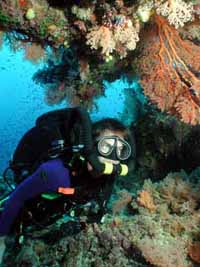 |
| Rob on Rebreather at Wakaya. |
|
The current should have allowed me to swim gently into it, maintaining my position in front of the richest, best-lit face of Cat's Meow. But it ripped around from behind and threatened to send me careening right into the massive IMAX® camera that Howard was somehow holding stationary. Next to him, Bob Cranston hovered gracefully, aiming the 5000-watt surface-supplied lights at the soft coral - and into my eyes.
Given the significance of the performance, I considered my options as carefully as I could in the two seconds I had to slow down. One choice was to grab chunks of coral as I flew past. But that might not look good on a screen nearly as wide as NAI'A is long. I was sure that, even with a super wide-angle lens, IMAX® viewers would be able to see the terror in my eyes as I pretended to enjoy the view while actually calculating my path of least destruction. I didn't want to crash into the camera rig's dome port, because I knew there wasn't a spare. But I was equally reluctant to take out the lights because I was vaguely worried about instant electrocution. Most of all, with the camera chewing through film at seventeen dollars a second, I certainly didn't want to mess up my 15 seconds of fame. |
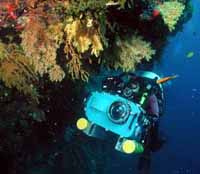 |
| Howard at Siph Wall, Mt. Mutiny |
|
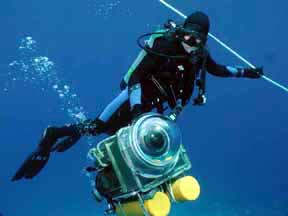 |
| Conlin with W14. |
As I should have known he would, Bob saved the shot. Uncannily able to keep track of everything going on at once, Bob saw the developing drama and didn't even bother to warn Howard - whose face was glued to the viewfinder in blissful ignorance. Bob waited 'til the last instant before impact, then deftly shifted the lights with one hand and deflected my course with the other. While I spun off out of control down current, I heard Howard mumble something into his underwater communications unit that I took for "not too bad". Although I wonder now if he actually said, "Rob, you spaz."
Cat and I had never used these 'coms' units before and we first thought they were the kind of things that Club Med dive masters might use to corral their students. But when eight different divers spread out beyond visual range have to be coordinated simultaneously with the surface support crew, it soon became clear that we could not have achieved half of what we did without those underwater speaking and listening units. The rebreather divers had microphones built into their double hose regulators but, even though they had just short of a gazillion dives with the units, their underwater vocalizations were nearly unintelligible. The master unit was in one of the skiffs moored above the site so that the topside crew could hear what was going on and be prepared to retrieve the camera, change the film and/or the lens, turn on or off the lights, or warn the cook on the mother-ship that we were finally coming home for lunch at 3:00. |
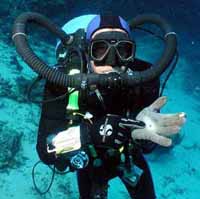 |
| Bob with tiny nudi. |
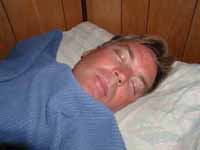 |
| Hard work. |
|
|
At the start of every dive Howard went down to scope out his next shot. Eventually he called through his coms, "raunch the carrot". While we all knew Howard had a great sense of humor, we finally realized he meant for us to launch the camera.
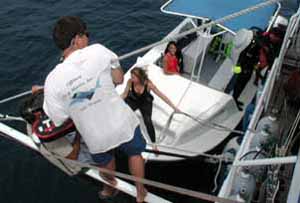 |
| Brad and John from skiff scene. |
In the camera skiff, John Anderson slated the shot, then Brad Ohlund and the skiff driver used a crane and winch to lift the 250lb housing over the side and into the water, where Mark Conlin and Betty Almogy were waiting to swim it down to the camera team below. From the other skiff, which housed the gasoline generator to power the lights, Bob, Mark Thurlow and Peter Kragh collected the lights and the tripod that, at 65 pounds, required a lift bag to maneuver as well as 75 pounds of weights to stabilize under the housing. |
|
|
|
(story continued on next page)
1 - Next Page - 3 - 4
|
|
|